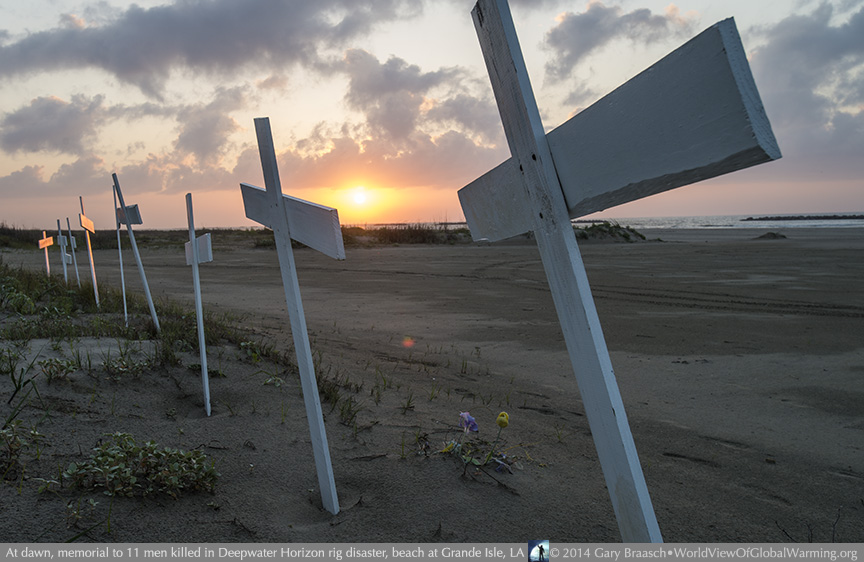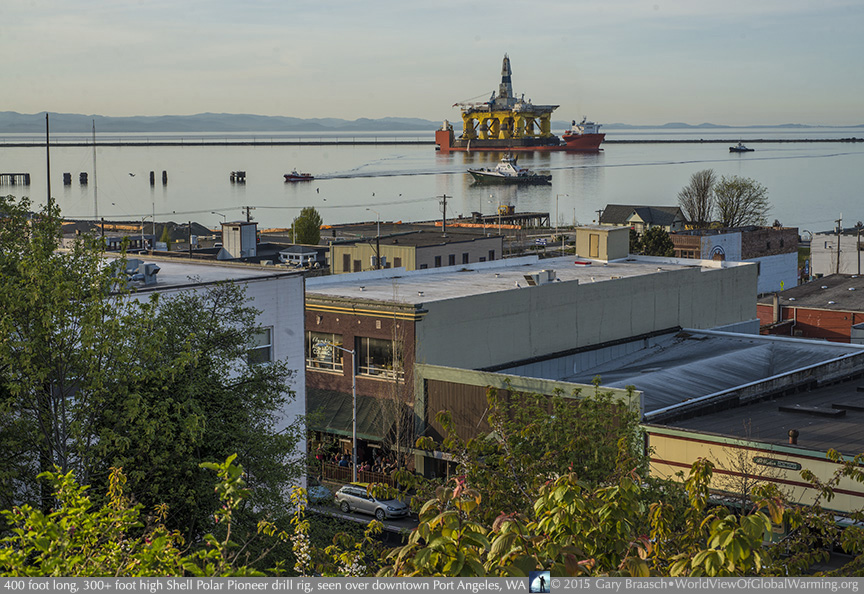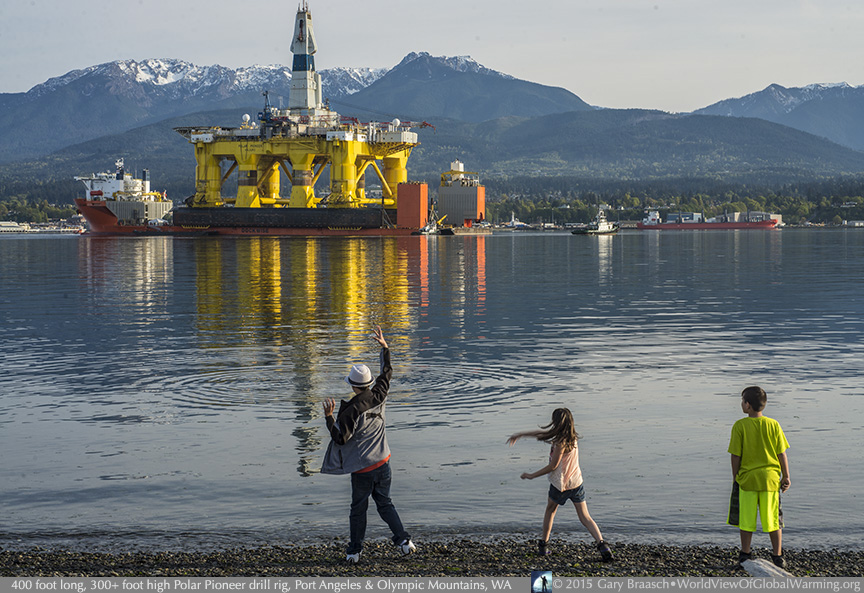Giant ocean drill rig, physical manifestation of Shell’s risky bid to resume Arctic oil drilling, arrives in Washington State on 5th anniversary of BP Gulf oil disaster
The enormous physical form of Shell’s Arctic plans sailed into Port Angeles, Washington’s small harbor April 17, in the shape of the Polar Pioneer rig — three days before the anniversary of the explosion and fire on BP’s Deepwater Horizon. It is also little more than two years after Shell damaged its previous Alaska rig, the Kulluk, through documented mistakes in equipment, management and judgement. The Polar Pioneer rig is 400 feet wide and more than 300 feet high, about the same size as the Deepwater Horizon, and like that rig and many others uses underwater prop thrusters to float on position over a drilling site.

On April 20, 2010 the Deepwater Horizon floating oil rig drilling a well 50 miles SE of Venice, Louisiana, exploded, killing 11 workers, injuring 26 others and unleashing an estimated more than 200 million gallons of crude into the Gulf of Mexico from the broken wellhead a mile underwater, until it was capped in mid-July. The BP and government response to the damaged Delta landscape, jobs, wildlife and health has cost many billions of dollars and is still awaiting final financial charges to BP. The extent of damages is controversial scientifically and legally and is a long way from being known in full.
Interior Department records show that there has been an average of more than 850 reported offshore oil spill incidents a year from 2010 to 2014, all much smaller, but the number creates great concern about oil drilling in the Arctic Ocean. The most recent Environmental Impact Statement about Shell’s planned drilling off Alaska in the Chukchi Sea estimated a 75 percent chance of a 1000 barrel (42,000 gallons) or larger oil spill during the life of the drilling project — this in one of the richest wildlife and fish regions of the Arctic, most likely under ice, and far from the resources that were relatively easily accessible to fight the Gulf spill.

Part of Shell’s plan, its overall revised multi-year Exploration Plan (EP) for the Chukchi Sea, gained conditional approval from one part of the Interior Department on May 11. The Bureau of Ocean Energy Management (BOEM) said that “among the conditions of approval is the requirement that Shell obtain all necessary permits from other state and federal agencies, including permits to drill from the Bureau of Safety and Environmental Enforcement (BSEE) and appropriate authorizations under the Marine Mammal Protection Act. Another condition of approval prevents Shell from commencing drilling operations until all Biological Opinions under the Endangered Species Act have been issued and requires all operations under the plan comply with the terms and conditions included in those Biological Opinions."
Shell is also confronting protesters and a newly antagonistic Seattle city hall. Seattle Mayor Ed Murray said allowing Shell to use Seattle Port facilities was “the wrong direction for any community, but double so for King County, with our environmental ethic and enormous capacity to invent the future.” The city’s planning department said Shell and its Seattle maritime servicing company would have to get a new least on Terminal 5, because oil ships are not cargo related. Meanwhile, Shell was granted a restraining order to keep Greenpeace from getting near the rigs through October. Concerned citizens, environmental and climate focused groups have planned Seattle harbor protests, including flotillas of kayaks. The lawsuits and protests are being driven not only by fears of oil spill damage, but also by the demonstrated need to sharply reduce fossil fuel exploration and use, to limit greenhouse gases. A Shell spokesperson said the company had port alternatives, thought to be Everett WA in Puget Sound, Portland OR and Dutch Harbor, Alaska. Shell’s two rigs, the Polar Pioneer and its even larger Noble Discoverer, were due into Seattle mid-May. The Discoverer is reportedly going to dock in Everett first.
For more on Shell, the Mayor and the Port of Seattle, see Joel Connelly’s blog in the Seattle P-I. For details on the Interior Department decision on Shell’s Arctic drill plan, see the NY Times.

This project would be impossible without scientists and observers around the world who have provided hundreds of scientific contacts and papers. See Background, Advisors, and Reference for documentation, funders and major advisors, without whom I could not complete the work.
World View of Global Warming is a project of the Blue Earth Alliance, Seattle Washington, a 501(c)3 tax-exempt organization. The project is supported entirely by donations, grants, and license fees for the photographs. Please see information about how to contribute.
For other information about Gary Braasch's climate change projects and books, please see the books Earth Under Fire and How We Know What We Know About Our Changing Climate, and the exhibit "Climate Change in Our World" at the Books and Exhibits link on the top menu of this page.
COPYRIGHT NOTICE:
Photography and text Copyright © 2005 - 2017 (and before) Gary Braasch All rights reserved. Use of photographs in any manner without permission is prohibited by US copyright law. Photography is available for license to publications and other uses. Please contact requestinformation@worldviewofglobalwarming.org. View more of Gary Braasch's photography here.


